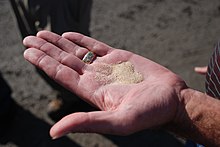User:InexorableAlloy/Driftless Area
| This is the sandbox page where you will draft your initial Wikipedia contribution.
If you're starting a new article, you can develop it here until it's ready to go live. If you're working on improvements to an existing article, copy only one section at a time of the article to this sandbox to work on, and be sure to use an edit summary linking to the article you copied from. Do not copy over the entire article. You can find additional instructions here. Remember to save your work regularly using the "Publish page" button. (It just means 'save'; it will still be in the sandbox.) You can add bold formatting to your additions to differentiate them from existing content. |
Economy
[edit]Agriculture
The natural characteristics of the Driftless Area provide good conditions for growing crops and grazing livestock. In recent years, the region has generated much interest in the organic and artisanal food market.
Organic dairy and beef production is of particular economic significance to the Driftless Region. Organic Valley, the largest organic dairy cooperative in the United States, was founded and is headquartered in La Farge, Wisconsin. The region's cheese production boasts specialty cheeses such as raw-milk artisan cheese, which is made from unpasteurized milk[1]. Generally, organic dairy production fits best with a grass-based milk production system[2]. and has great potential to market forest botanicals - especially mushrooms - to the 21 million people in the region, including the relatively nearby Minneapolis-St. Paul, Chicago, and Milwaukee markets.
The economic and cultural characteristics of the bioregion were federally recognized with the granting of the Upper Mississippi River Valley (UMRV) viticultural area, the largest designated winemaking region in the country, by the Treasury Division's Tax and Trade Bureau in 2009. The petition for designation details why the region is a cohesive whole for marketing wine, and is now used to market other products[3]. In addition to wine-grape production and wine-making, the region, especially in Southeast Minnesota, is known for apple production. Tobacco was also once a key crop of the Driftless, as its topography and sandy, nutrient-rich soil are suitable for its growth[4].
The Driftless Region Food and Farm Project, in partnership with the University of Wisconsin-Madison Center for Integrated Agricultural Systems, is a coalition of sustainable-agriculture farmers, processors, distributors, chefs, planning commissions, and other participants. This project seeks to define the culinary identity of the region and further direct the development of agritourism.
Mining

Due to the presence of sandstone bedrock at or near the surface, sand mining is an industrial activity in the Driftless, with Wisconsin being at the forefront of the industry[5]. The sandstone contains quartz (silica) sand grains of the required hardness, shape, size, and purity that make it ideal for use in hydraulic fracturing (commonly known as fracking) utilized by the petroleum and natural gas industries during drilling operations. The mining activity involves quarrying the sandstone bedrock by blasting with dynamite, crushing the rock, washing, drying, and grading the resulting sand, and transporting the sand out of the region via barge or train[6]. In 2017, there were 73 frac sand mines in operation[7]; therefore, the proliferation of sand mines in the region has created new jobs and generated economic activity. However, the prominence of industry has fueled controversy due to opposition of nearby residents and environmentalists concerned about impacts to water quality, air pollution caused by silica dust, noise and light pollution, heavy truck traffic, and the destruction of hills and ridges for which the region is known. Recently, industry changes have caused companies such as Hi-Crush, Covia, Superior Silica Sands— all with operations in Wisconsin— to liquidate their frac sand mines and declare bankruptcy[8].
References
[edit]- ^ "Raw Milk Questions and Answers". Center for Disease Control and Prevention. 2017.
{{cite web}}: CS1 maint: url-status (link) - ^ "Transitioning to Organic Dairy Production" (PDF). Midwest Organic and Sustainable Education Service (MOSES). 2012.
- ^ "T.D. TTB-77, Establishment of the Upper Mississippi River Valley Viticultural Area". Regulations.gov. June 21, 2009.
{{cite web}}: CS1 maint: url-status (link) - ^ "Norweigans and Tobacco in Western Wisconsin". Annals of the Association of American Geographers. 61: 685. 1971 – via JSTOR.
- ^ "Overview of Frac Sand Mining". University of Wisconsin River Falls.
{{cite web}}: CS1 maint: url-status (link) - ^ "Frac sand: How is it mined?". Wisconsin Geological and Natural History Survey.
{{cite web}}: CS1 maint: url-status (link) - ^ "Sand Rush in Wisconsin". Earth Observatory. November 7, 2017.
{{cite web}}: CS1 maint: url-status (link) - ^ Kremer, Rich (May 24, 2021). "Frac Sand Company Liquidating Western Wisconsin Mine". Wisconsin Public Radio.
{{cite web}}: CS1 maint: url-status (link)
